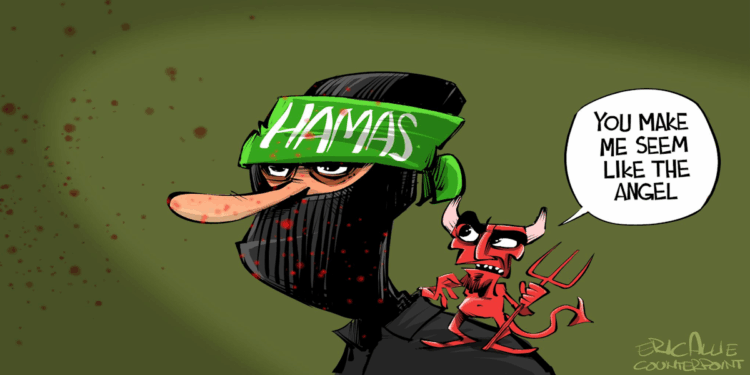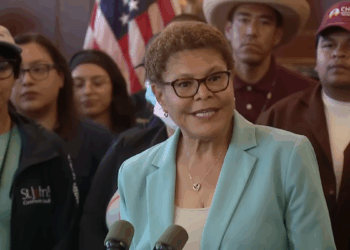For once, The New York Times played it relatively straight, revealing a 20-point Gazan ceasefire proposal jointly presented on Monday by both President Donald Trump and Israeli Prime Minister Benjamin Netanyahu, with only the comment that Hamas has previously rejected some points of the proposal. Fair enough: The terrorist leaders of Hamas have been a tough nut to crack for nearly two decades since seizing power in 2006. So getting them on board would always be considered the hard part.
But the proposal has some interesting carrots to go with the big stick of Trump’s threat, should Hamas say no to the deal. “Bibi, you’d have our full backing to do what you would have to do,” the president told the Israeli leader.
In return for freeing the hostages and laying down arms, Hamas fighters would enjoy a sort of amnesty as well as free passage to any other nation that would take them, according to the proposal. (However, they’re being encouraged to stay and assist in the rebuilding.) Gazans would be governed by a “Board of Peace” led by Trump, along with former British Prime Minister Tony Blair and other unspecified “high-profile participants.”
While the Israeli leader talked tough in a speech before the United Nations last week, vowing to “finish the job” with Hamas, he was far more conciliatory in the meeting with Trump. A somewhat chastened Netanyahu delivered a formal apology via a phone call from the White House to Qatar’s prime minister for Israel’s recent raid on what they believed to be a Hamas headquarters in Doha. A White House statement indicated that Netanyahu “expressed regret that, in targeting Hamas leadership during hostage negotiations, Israel violated Qatari sovereignty and affirmed that Israel will not conduct such an attack again in the future.”
In joint remarks with Trump, the Israeli leader endorsed the prospective deal and explained why he had pursued it. “This can be done the easy way, or it can be done the hard way, but it will be done,” said Netanyahu. “We prefer the easy way, but it has to be done. All these goals must be achieved because we didn’t fight this horrible fight, sacrifice the finest of our young men to have Hamas stay in Gaza and threaten us again and again and again with these horrific massacres.” Unfortunately, that’s been the end result of all the previous ceasefires and peace deals with Hamas, meaning they have to be eliminated as a participant one way or the other. The hard way would certainly lead to more misery in Gaza.
Trump acknowledged that Gaza civilians have borne the brunt of the fighting. “They don’t want the life that they’ve had. They’ve had a rough life with Hamas,” he said. “If the Palestinian Authority does not complete the reforms that I laid out and my vision for peace in 2020, they’ll have only themselves to blame.”
Andrew McCarthy, who spent much of his career as a federal prosecutor dealing with radical Islamic terrorists, understands the blame all too well. “There is no deal with sharia-supremacist Islam,” he writes. “Hamas, the Palestinian branch of the Muslim Brotherhood, is conducting a jihad to destroy Israel — not to reach a more favorable arrangement with Israel, to destroy Israel — based on sharia-supremacist principles, which are 14 centuries old and steeped in Jew hatred that goes back to Muhammad’s wars of conquest. What’s more, while Hamas has been hollowed out by Israel’s combat operations, the problem in the region is sharia supremacism, not Hamas; if what is today called Hamas disappeared tomorrow, a new jihadist entity would rise quickly to take its place, and the objective would not change.”
Nevertheless, the theme for the meeting was optimism. “I believe that today, we’re taking a critical step towards both ending the war in Gaza and setting the stage for dramatically advancing peace in the Middle East, and I think beyond the Middle East and very important Muslim countries,” Netanyahu added. If Trump and Netanyahu can pull this off, it’s a good first step toward Middle East peace and the vaunted “two-state solution” that our allies seem to be rushing to embrace, even before a pact has been reached.
Out of the 20 steps to stopping the conflict, though, perhaps the most important one to create a truly lasting peace is one that’s buried near the end. Point number 18 states, “An interfaith dialogue process will be established based on the values of tolerance and peaceful coexistence to try and change mind-sets and narratives of Palestinians and Israelis by emphasizing the benefits that can be derived from peace.” Since Israel was created in 1948 — and almost immediately was attacked by its Arab neighbors — there have been three or four generations of “Palestinians” who have been inculcated from birth that Israeli Jews are their sworn enemy and blamed for their issues. That same Jew-hatred was used to justify the Holocaust.
Economic aid and the building up of war-torn Gaza into a sustainable economy is an admirable goal that will take several years and billions of dollars’ worth of aid from around the globe to accomplish, similar to our rebuilding of Europe and Japan after World War II.
All the rebuilding will come to naught, however, without realizing that the real road to peace will only begin when hearts and minds are changed.















